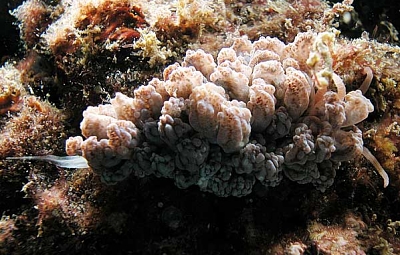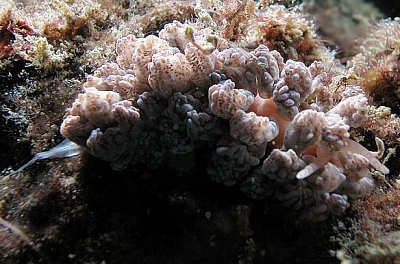

Phyllodesmium sp. 12
Order: NUDIBRANCHIA
Suborder: AEOLIDINA
Family: Glaucidae
PHOTO
Locality: Old Woman Island, Mooloolaba, Sunshine Coast, 9 m, Queensland, Australia, Pacific Ocean, 29 November 2003, Subtidal. Length: 70 mm. Photographer: Gary Cobb.
Photographed with xeniid colony so probably a xeniid feeder. The only other other xeniid feeder with longitudinal ridges on the upper half of the cerata (vertical when cerata standing up) is Phyllodesmium rudmani, but in that species the ridges are all around the ceras while in your animal they only seem to be on the outer half. Similar to P. lizardensis but in that species the secondary ridges are really a series of nodules. However in both those species the ridges are covered in opaque white, meaning the brown speckling [which represents digestive gland branches filled with zooxanthellae] is restricted to the 'valleys' between the ridges. There is no white pigmentation in your animal and there appears to be brown pigmentation, in the ridges.
This is possibly another unnamed species of Phyllodesmium.
Authorship detailsRudman, W.B., 2008 (September 3) Phyllodesmium sp. 12 [In] Sea Slug Forum. Australian Museum, Sydney. Available from http://www.seaslugforum.net/find/phyllodsp12
Related messages
Re: The new Phyllodesmium lizardensis from sthn Queensland
September 3, 2008
From: Ingo Burghardt
Concerning message #21842:
Dear Bill and Gary,
After working with this genus for a number of years I know that even single individuals can show a different appearance at different times (depending on their activity state; see our recent paper). But the cerata of this individual here neither look like the ones of P. lizardensis nor like the cerata of P. rudmani. My gut tells me that this is another undescribed Phyllodesmium species...
Cheers,
Ingo
ingo.burghardt@rub.de
Burghardt, I., 2008 (Sep 3) Re: The new Phyllodesmium lizardensis from sthn Queensland. [Message in] Sea Slug Forum. Australian Museum, Sydney. Available from http://www.seaslugforum.net/find/21859Dear Ingo,
Thanks for the quick response. I agree with your 'gut feeling'. It looks like there are a lot of xeniid-feeders out there. I will call it Phyllodesmium sp. 12.
Best wishes,
Bill Rudman
The new Phyllodesmium lizardensis from sthn Queensland?
September 2, 2008
From: Gary Cobb

Hi Bill and everyone,
Here is another animal I thought might be the newly described species Phyllodesmium lizardensis.
Locality: Old Woman Island, Mooloolaba, Sunshine Coast, 9 m, Queensland, Australia, Pacific Ocean, 29 November 2003, Subtidal. Length: 70 mm. Photographer: Gary Cobb.
Cheers
Gary
gary@nudibranch.com.au



Dear Gary,
This is an interesting - if perplexing - find. From the xeniid colony in your lower photo I guess we can say its associated with xeniids which would put P. lizardensis as a real possibility. The only other other xeniid feeder with longitudinal ridges on the upper half of the cerata (vertical when cerata standing up) is Phyllodesmium rudmani, but in that species the ridges are all around the ceras while in your animal they only seem to be on the outer half, which would support P. lizardensis. However in both these species the ridges are covered in opaque white meaning the brown speckling [which represents digestive gland branches filled with zooxanthellae] is restricted to the 'valleys' between the ridges. There is no white pigmentation in your animal and there appears to be brown pigmentation, in the ridges.
I guess it is early days in our knowledge of variation in both these species, so it is possibly an example of P. lizardensis without white pigmentation. If so it means branching in the digestive gland is also variable. Perhaps Ingo Burghardt has an opinion?
Best wishes,
Bill Rudman
